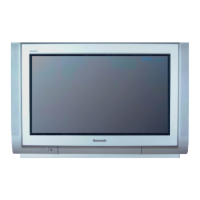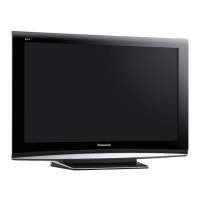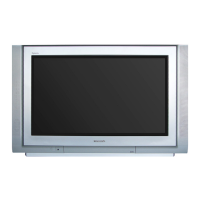Do you have a question about the Panasonic TX-33AK10F and is the answer not in the manual?
Essential safety precautions for operating the TV, including electrical hazards and environmental considerations.
The main manual detailing TV operation and features.
Document providing warranty information for the television set.
Details and instructions for the remote control and its required batteries.
Guidance on correctly inserting batteries into the remote control.
Steps for initial TV setup including connections and tuning.
Connecting and configuring a Q-Link compatible VCR.
Using the Geomagnetic Correction feature to fix picture tilt or colour patches.
Resetting picture controls and connecting external audio equipment.
Instructions for basic operation like adjusting volume and changing channels.
Explanation of buttons and indicators on the TV's front panel.
Description of buttons on the remote control and their functions.
How to navigate through menus using buttons and cursor controls.
Explanation of special buttons like STR, TV/AV, and HELP for menu control.
Automatic selection of the correct picture format (16:9 or 4:3).
Displaying content in the standard 4:3 aspect ratio.
Displaying content in the widescreen 16:9 aspect ratio.
Magnifying and adjusting picture position horizontally and vertically.
Using the STILL key to freeze the current picture on screen.
Adjusting Contrast, Brightness, Colour, and Sharpness for desired picture quality.
Fine-tuning picture quality with Colour Balance, noise reduction, and AI analysis.
Adjusting Volume, Bass, Treble, and Balance for optimal audio output.
Configuring headphone volume, AI sound processing, MPX, and sound modes.
Accessing the Surround menu for Dolby Pro Logic and simulated modes.
Configuring the signal output for the AV2 SCART socket.
Selecting Teletext display modes like FLOF/TOP or LIST.
Setting the auto power-off timer and adjusting flicker reduction.
Enabling Q-Link for VCR communication and accessing tuning features.
Choosing the display language for on-screen menus.
Managing TV channels: moving, adding, deleting, naming, or locking.
Automatically scanning and tuning local TV stations.
Manually tuning individual programme positions.
Making small tuning adjustments and selecting the correct transmission standard.
Adjusting station volume levels and configuring the AV2 decoder.
Accessing and navigating the Programme Edit menu.
Steps to delete an unwanted programme from the TV's memory.
Instructions for adding a new programme position to the TV.
Procedure to move an existing programme to a different position.
Manually tuning a specific programme position for clear reception.
Steps to change the name displayed for a programme.
Preventing access to specific programme positions.
Selecting the correct TV system (PAL/SECAM) for a programme.
Transferring programme information from the TV to a compatible VCR.
Starting the automatic tuning process to find local stations.
Choosing the country to ensure correct tuning for the region.
Accessing and using the on-screen manual tuning options.
Performing manual tuning using the TV's front panel controls.
Changing the language used for menus and messages on screen.
Choosing the active AV input source (AV1, AV2, etc.) to view.
Accessing the Setup menu for various TV configurations.
Accessing the Sound menu for audio adjustments.
Enabling TV to VCR communication via SCART and Q-Link.
Using Q-Link to instruct a VCR to record the current program.
Ensuring TV and VCR share tuning data for accurate recordings.
Automatic TV switching and input selection with Q-Link VCRs.
Instructions on how to turn off the Q-Link communication feature.
Explanation of Dolby Pro Logic and Simulated surround modes.
Details on Pro Logic and Simulated mode selections.
Adjusting output levels for individual speakers (Front, Rear, Centre).
Setting up for Normal mode with front and rear speakers.
Using Phantom mode when front speakers are disconnected.
Using 3 Stereo mode when rear speakers are not connected.
Using 3D Active mode to simulate speakers without external connections.
Description of Disco, Movie, and Stadium simulated surround effects.
Setting individual speaker output levels for optimal sound.
Using the remote to operate VCR/DVD functions like Play, Stop, Skip.
Basic Teletext operation, including LIST and FLOF modes.
Selecting Teletext pages by navigation or direct entry.
Using functions like Full/Top/Bottom and Reveal for Teletext.
Storing and recalling favourite Teletext pages.
Viewing updates and news flashes on Teletext pages.
Accessing specific sub-pages within Teletext information.
Returning to the main index page in Teletext.
Connecting audio/video devices via front S-Video, RCA, and headphone sockets.
Pin assignments and details for Scart and S-Video sockets.
Connecting external devices to rear AV1, AV2(S), AV4(S) Scart and RCA terminals.
Connecting external speakers to the TV's rear terminals.
Connecting the TV's audio output to external amplifiers and speakers.
Common picture and sound problems and their potential causes and checks.
Information on obtaining service and contacting support.
Precautions for connecting games or computers to prevent screen damage.
How the automatic standby feature works when TV is idle.
Functions that retain their settings after the TV is switched off.
Key technical data including power, dimensions, and receiving systems.
Essential safety precautions for operating the TV, including electrical hazards and environmental considerations.
The main manual detailing TV operation and features.
Document providing warranty information for the television set.
Details and instructions for the remote control and its required batteries.
Guidance on correctly inserting batteries into the remote control.
Steps for initial TV setup including connections and tuning.
Connecting and configuring a Q-Link compatible VCR.
Using the Geomagnetic Correction feature to fix picture tilt or colour patches.
Resetting picture controls and connecting external audio equipment.
Instructions for basic operation like adjusting volume and changing channels.
Explanation of buttons and indicators on the TV's front panel.
Description of buttons on the remote control and their functions.
How to navigate through menus using buttons and cursor controls.
Explanation of special buttons like STR, TV/AV, and HELP for menu control.
Automatic selection of the correct picture format (16:9 or 4:3).
Displaying content in the standard 4:3 aspect ratio.
Displaying content in the widescreen 16:9 aspect ratio.
Magnifying and adjusting picture position horizontally and vertically.
Using the STILL key to freeze the current picture on screen.
Adjusting Contrast, Brightness, Colour, and Sharpness for desired picture quality.
Fine-tuning picture quality with Colour Balance, noise reduction, and AI analysis.
Adjusting Volume, Bass, Treble, and Balance for optimal audio output.
Configuring headphone volume, AI sound processing, MPX, and sound modes.
Accessing the Surround menu for Dolby Pro Logic and simulated modes.
Configuring the signal output for the AV2 SCART socket.
Selecting Teletext display modes like FLOF/TOP or LIST.
Setting the auto power-off timer and adjusting flicker reduction.
Enabling Q-Link for VCR communication and accessing tuning features.
Choosing the display language for on-screen menus.
Managing TV channels: moving, adding, deleting, naming, or locking.
Automatically scanning and tuning local TV stations.
Manually tuning individual programme positions.
Making small tuning adjustments and selecting the correct transmission standard.
Adjusting station volume levels and configuring the AV2 decoder.
Accessing and navigating the Programme Edit menu.
Steps to delete an unwanted programme from the TV's memory.
Instructions for adding a new programme position to the TV.
Procedure to move an existing programme to a different position.
Manually tuning a specific programme position for clear reception.
Steps to change the name displayed for a programme.
Preventing access to specific programme positions.
Selecting the correct TV system (PAL/SECAM) for a programme.
Transferring programme information from the TV to a compatible VCR.
Starting the automatic tuning process to find local stations.
Choosing the country to ensure correct tuning for the region.
Accessing and using the on-screen manual tuning options.
Performing manual tuning using the TV's front panel controls.
Changing the language used for menus and messages on screen.
Choosing the active AV input source (AV1, AV2, etc.) to view.
Accessing the Setup menu for various TV configurations.
Accessing the Sound menu for audio adjustments.
Enabling TV to VCR communication via SCART and Q-Link.
Using Q-Link to instruct a VCR to record the current program.
Ensuring TV and VCR share tuning data for accurate recordings.
Automatic TV switching and input selection with Q-Link VCRs.
Instructions on how to turn off the Q-Link communication feature.
Explanation of Dolby Pro Logic and Simulated surround modes.
Details on Pro Logic and Simulated mode selections.
Adjusting output levels for individual speakers (Front, Rear, Centre).
Setting up for Normal mode with front and rear speakers.
Using Phantom mode when front speakers are disconnected.
Using 3 Stereo mode when rear speakers are not connected.
Using 3D Active mode to simulate speakers without external connections.
Description of Disco, Movie, and Stadium simulated surround effects.
Setting individual speaker output levels for optimal sound.
Using the remote to operate VCR/DVD functions like Play, Stop, Skip.
Basic Teletext operation, including LIST and FLOF modes.
Selecting Teletext pages by navigation or direct entry.
Using functions like Full/Top/Bottom and Reveal for Teletext.
Storing and recalling favourite Teletext pages.
Viewing updates and news flashes on Teletext pages.
Accessing specific sub-pages within Teletext information.
Returning to the main index page in Teletext.
Connecting audio/video devices via front S-Video, RCA, and headphone sockets.
Pin assignments and details for Scart and S-Video sockets.
Connecting external devices to rear AV1, AV2(S), AV4(S) Scart and RCA terminals.
Connecting external speakers to the TV's rear terminals.
Connecting the TV's audio output to external amplifiers and speakers.
Common picture and sound problems and their potential causes and checks.
Information on obtaining service and contacting support.
Precautions for connecting games or computers to prevent screen damage.
How the automatic standby feature works when TV is idle.
Functions that retain their settings after the TV is switched off.
Key technical data including power, dimensions, and receiving systems.











